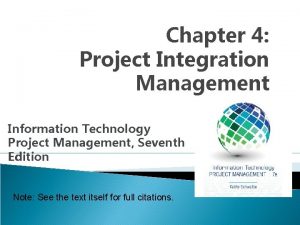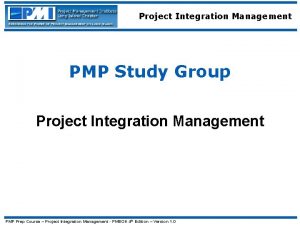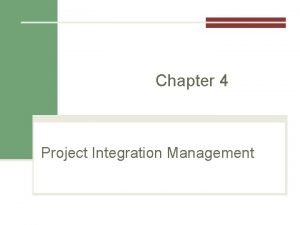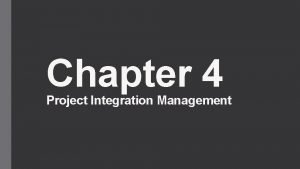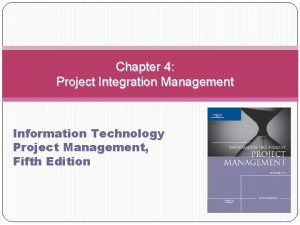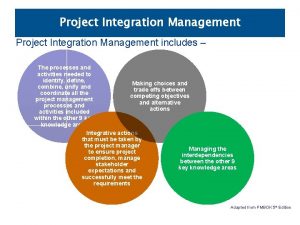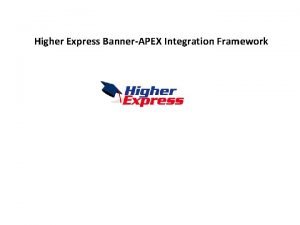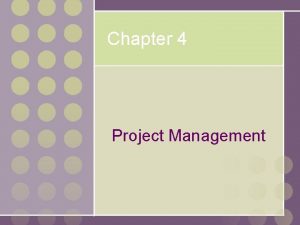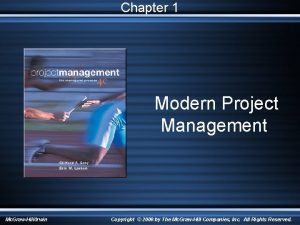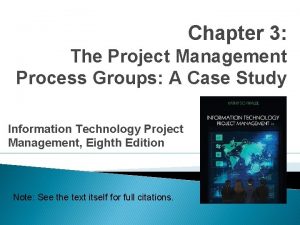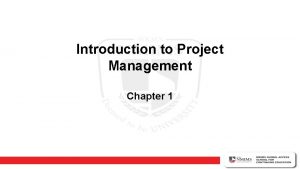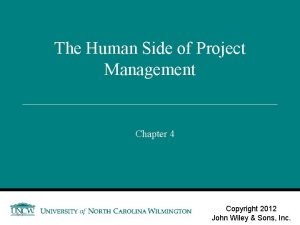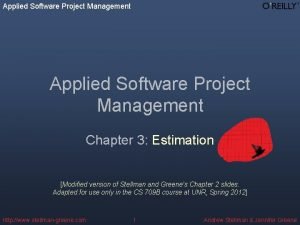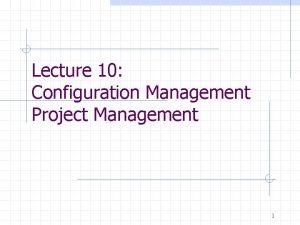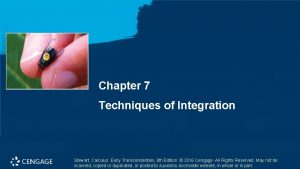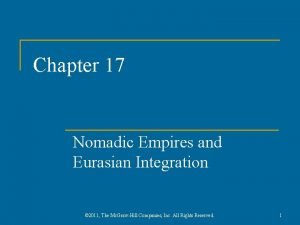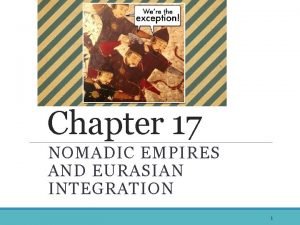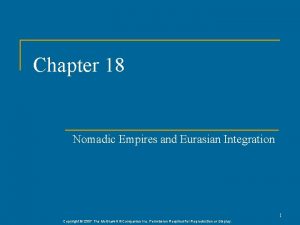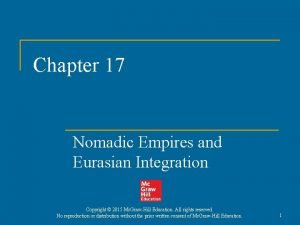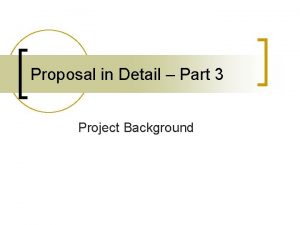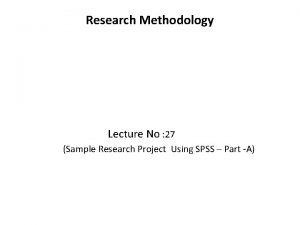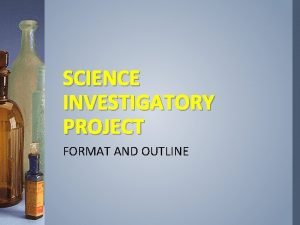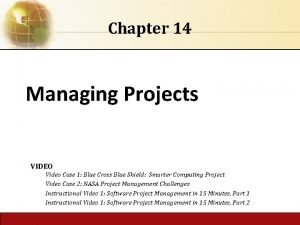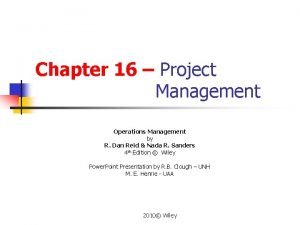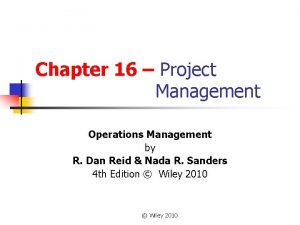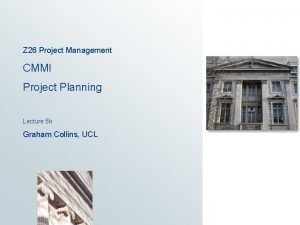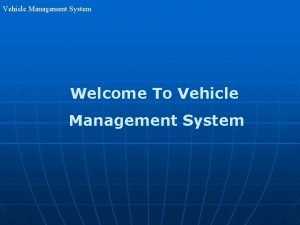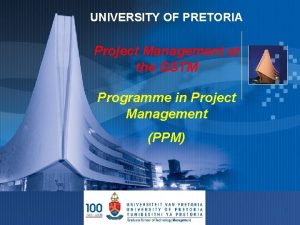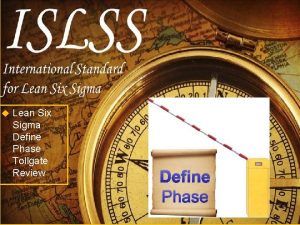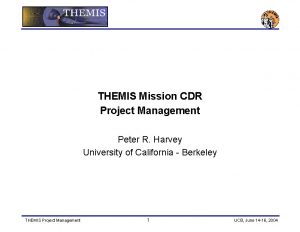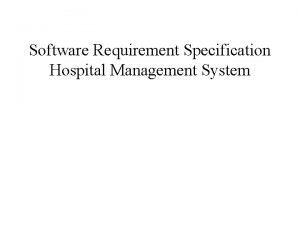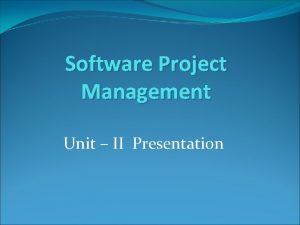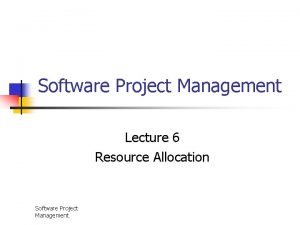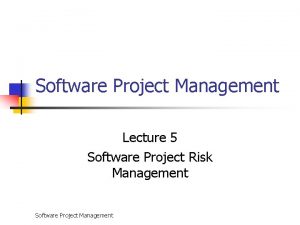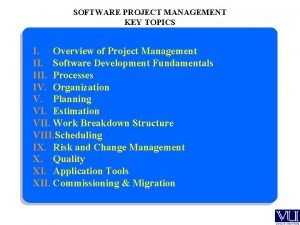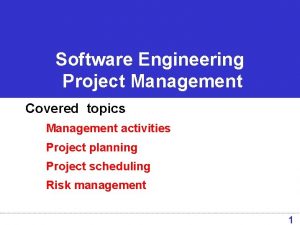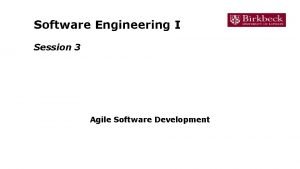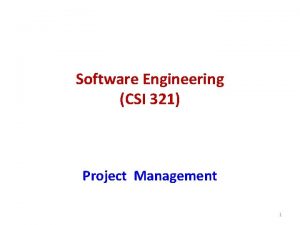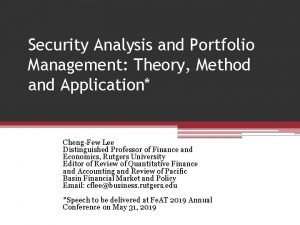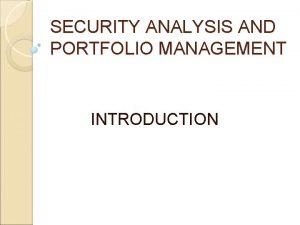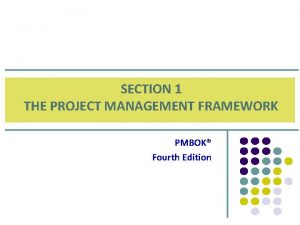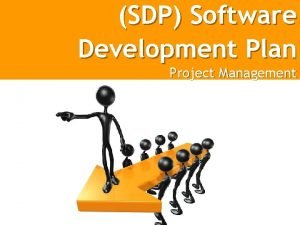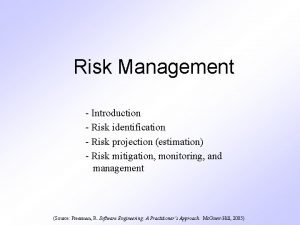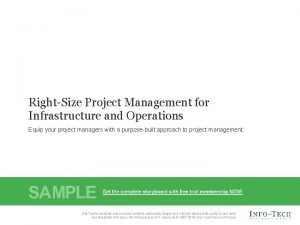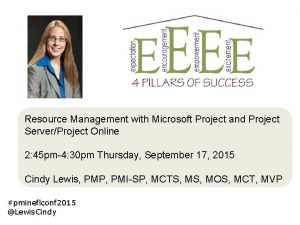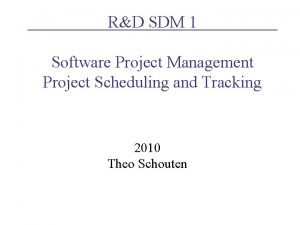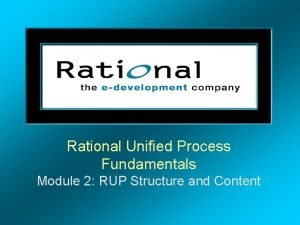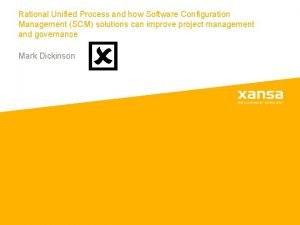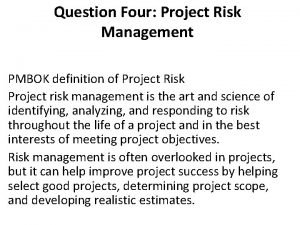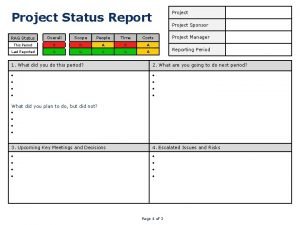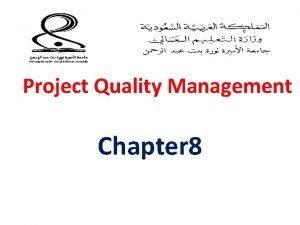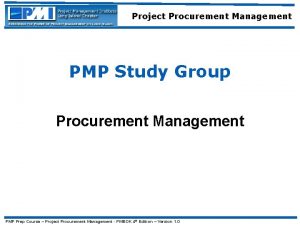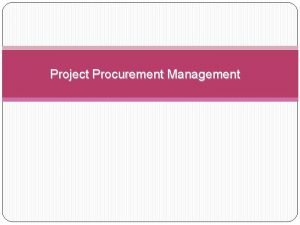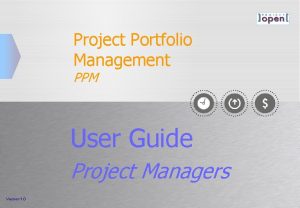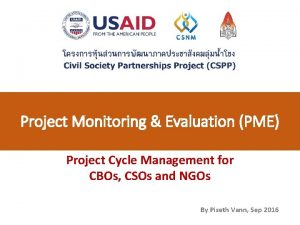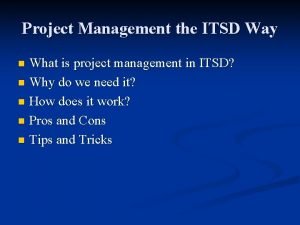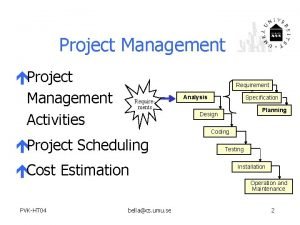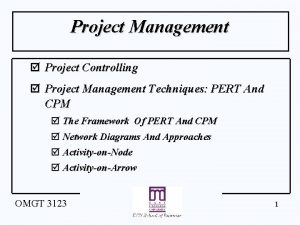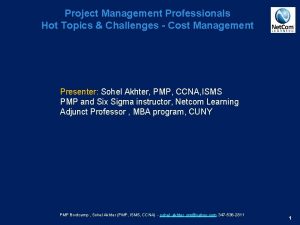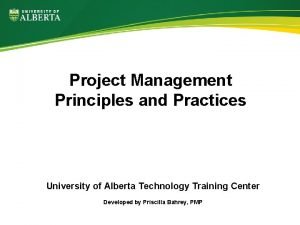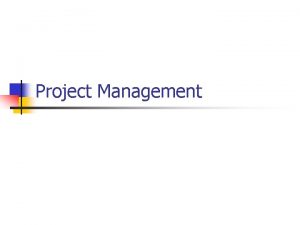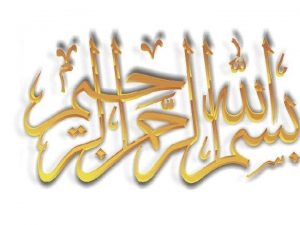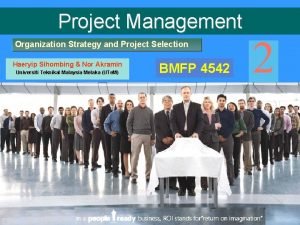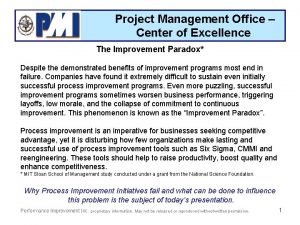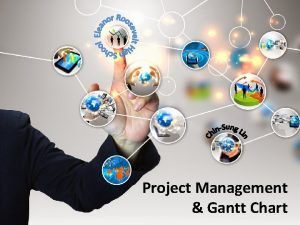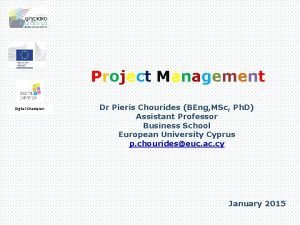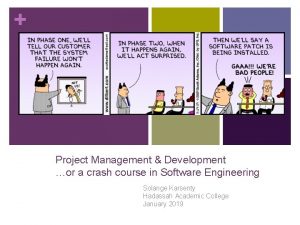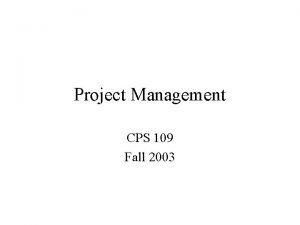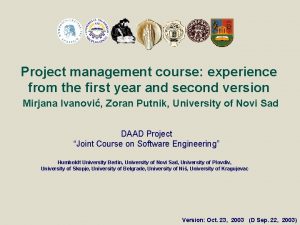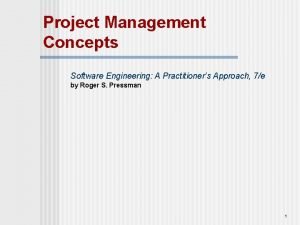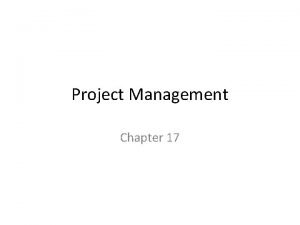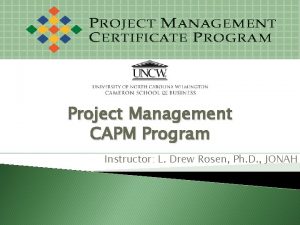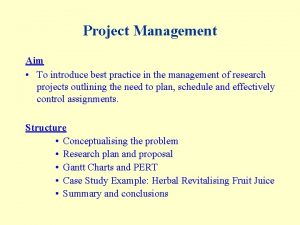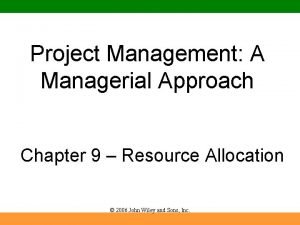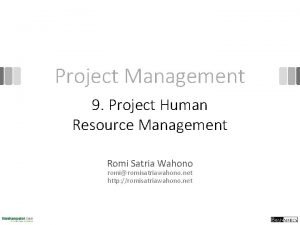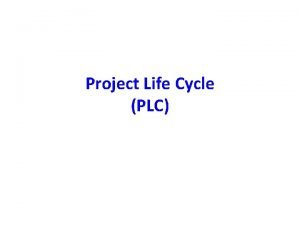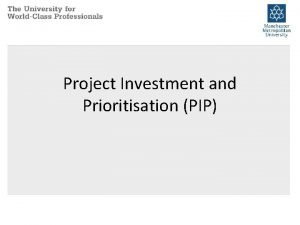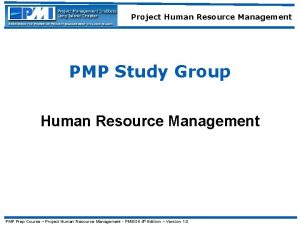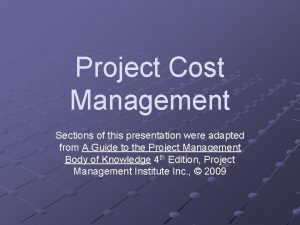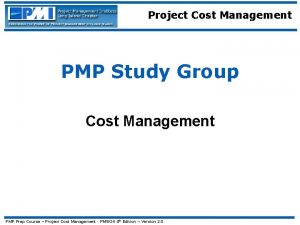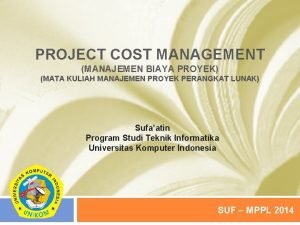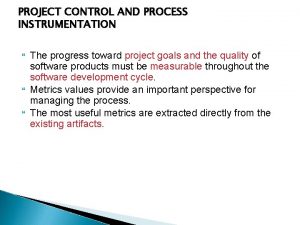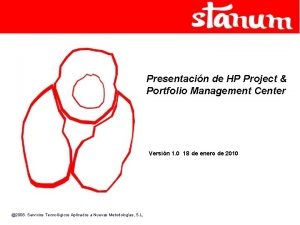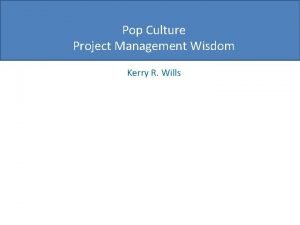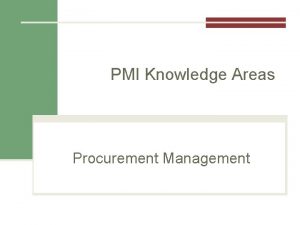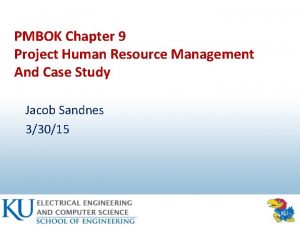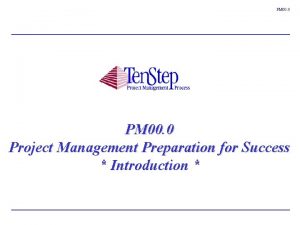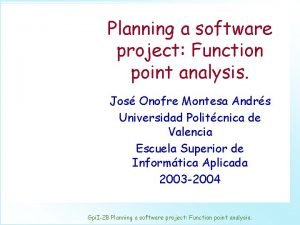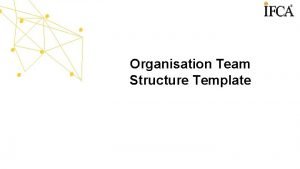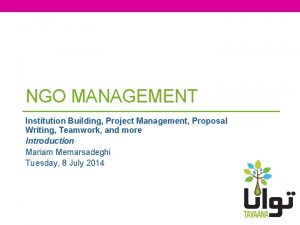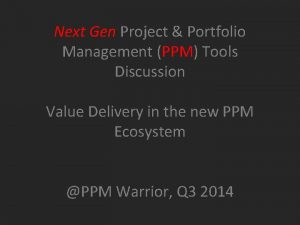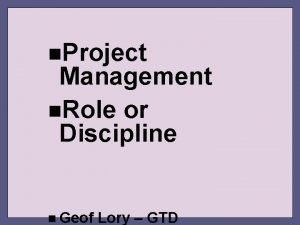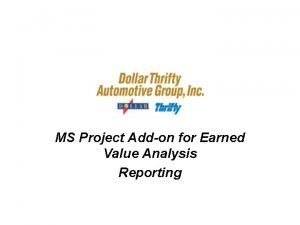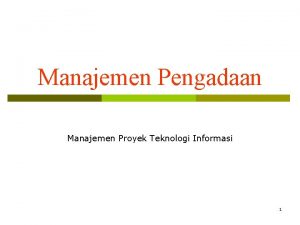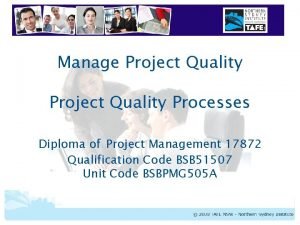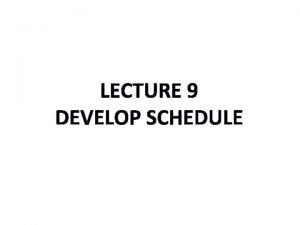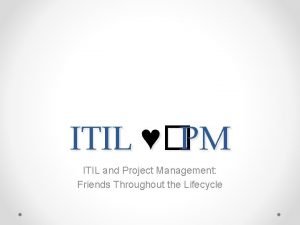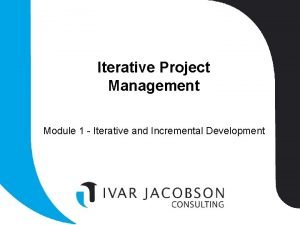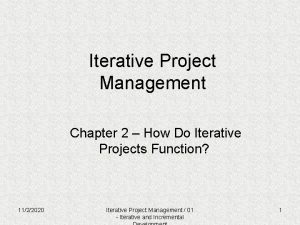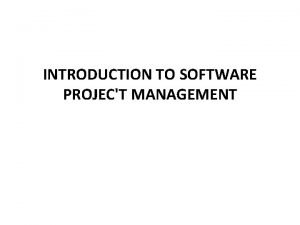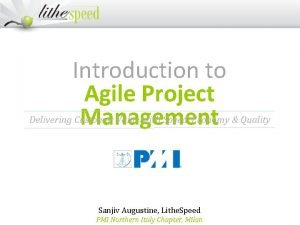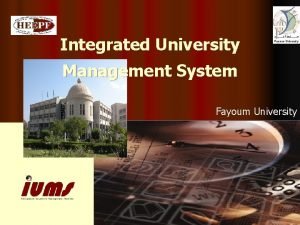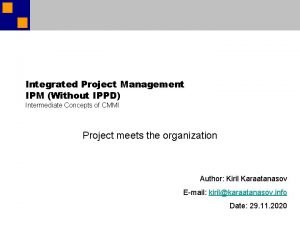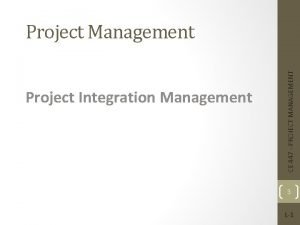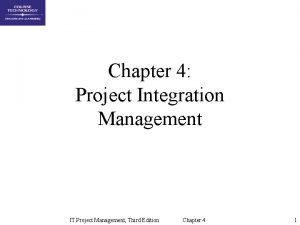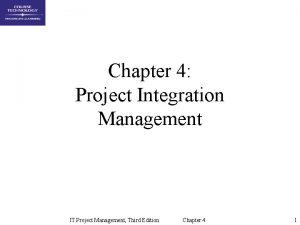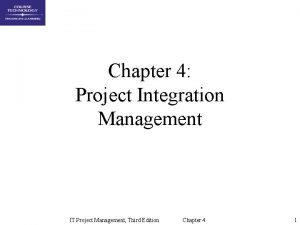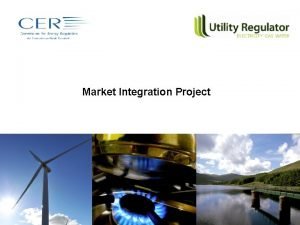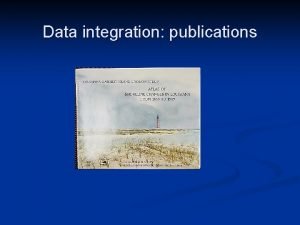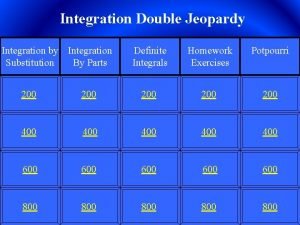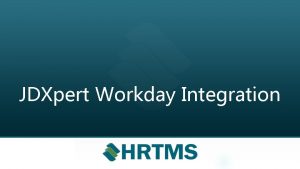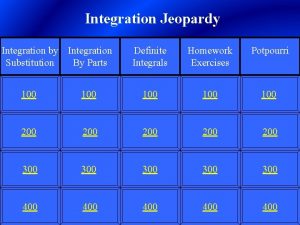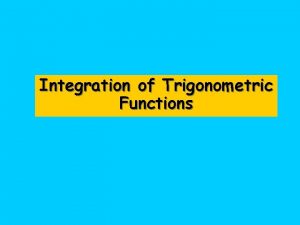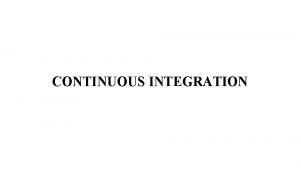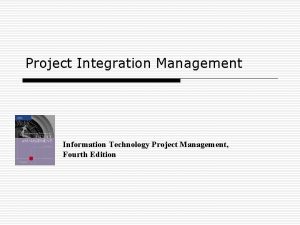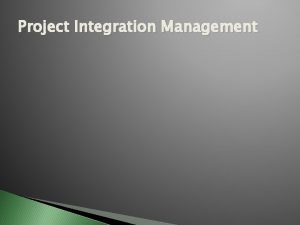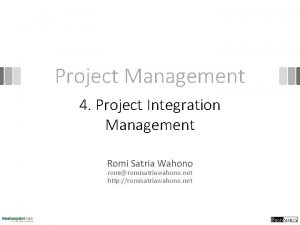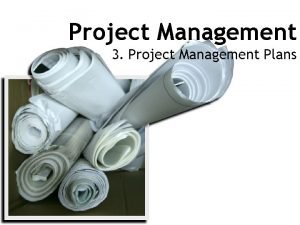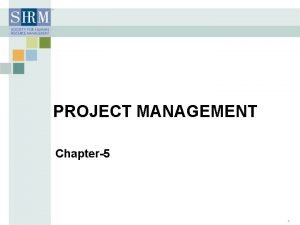Chapter 4 Project Integration Management Project Integration Management

















































































































































- Slides: 145

Chapter 4 Project Integration Management

Project Integration Management Includes the processes and activities to identify, define, and combine, unify and coordinate the various processes and project management activities within the Project Management Process Groups Integration includes characteristics of unification, consultation, communication and interrelationship.

Project Integration Management Continued. . Project Integration Management includes making choices about: • Resource allocation • Balancing competing demands • Examining any alternative approaches • Tailoring the processes to meet the project objectives • Managing the interdependencies among the Project Management Knowledge Areas.

The Project Integration Management Processes are • 4. 1 Develop Project Charter • 4. 2 Develop Project Management Plan • 4. 3 Direct and Manage Project Work • 4. 4 Manage Project Knowledge • 4. 5 Monitor and Control Project Work • 4. 6 Perform Integrated Change Control • 4. 7 Close Project or Phase

Figure 4 -1. Project Integration Management Overview

Key Concepts For Project Integration Management. • Project Integration Management is specific to project managers • The Project manager is the one who combines the results in all the other Knowledge Areas and has the overall view of the project, The project manager is ultimately responsible for the project as a whole

Project Integration Management is about: • Ensuring that the deliverable due dates of the product, service, or result; project life cycle; and the benefits management plan are aligned • Providing a project management plan to achieve the project objectives • Ensuring the creation and he use of the appropriate knowledge to and from the project as necessary • Managing the performance and changes of the activities in the project management plan • Making integrated decisions regarding key changes impacting the project

Project Integration Management continued • Measuring and monitoring the project’s progress and taking appropriate action to meet project objectives • Collecting data on the results achieved, analyzing the data to obtain information, and communicating this information to relevant stakeholders • Completing all the work of the project and formally closing each phase , contract, ad the project as a whole • Managing Phase transitions when necessary

Trends and Emerging Practices in Project Integration Management Evolving trends in integration processes include, but are not limited to: • Use of automated tools. • Use of visual management tools. • Project knowledge management. • Expanding the project manager’s responsibilities. • Hybrid methodologies

Tailoring Considerations Each project is unique. Considerations for tailoring include, but are not limited by: • Project life cycle. • Development life cycle • Management approaches Knowledge management Change Governance Lessons learned Benefits • • •

Considerations For Agile/Adaptive Environments • Iterative and agile approaches promote the engagement of team members as local domain experts in integration management. The team members determine how plans and components should integrate

4. 1 Develop Project Charter • Process of developing a document that formally authorizes the existence of a project and provides the project manager with the authority to apply organizational resources to project activities. The key benefits provide a direct link between the project and the strategic objective of the organization, creates a formal record of the project, and shows the organizational commitment to the project. • This is performed once or at predefined points in the project

• Figure 4 -2, Develop Project Charter: Inputs, Tools & Techniques, and Outputs • Figure 4 -3. Develop Project Charter: Data Flow Diagram

4. 1 Develop Project Charter Continued… • The project charter establishes a partnership between the performing and requesting organizations • The approved project charter formally initiates the project • Projects are initiated by an entity external to the project such as a sponsor, program, or project management office (PMO), or a portfolio governing body chairperson or authorized representative

4. 1. 1 Develop Project Charter: Inputs 4. 1. 1. 1 Business Documents The business case and the benefits management plan are sources of information about the project’s objectives and how the project will contribute to the business goals

Business Case • • Market demand Organizational need Customer Request Technological advance Legal requirement Ecological impacts Social need The project charter incorporates the appropriate information for the project from the business documents. The project manager does not update or modify the business documents since they are not project documents

4. 1. 1. 2 Agreements Initial intentions for a project may take the dorm of contracts, memorandums of understanding (MOUs), service level agreements (SLA), letters of agreement letters of intent, verbal agreements, email, or other written agreements.

4. 1. 1. 3 Enterprise Environmental Factors • Government or industry requirements and/constraints • Marketplace conditions • Organizational culture and political climate • Organizational governance framework (a structures way to provide control, direction, and coordination through people, policies, and processes to meet organizational strategic and operational goals) • Stakeholders’ expectations and risk thresholds.

4. 1. 1. 4 Organizational Process Assets • Organizational standard policies, processes, and procedures • Portfolio, program, and project governance framework (governance functions and processes to provide guidance and decision making) • Monitoring and reporting methods • Templates (e. g. , project charter template) • Historical information and lessons learned repository (e. g. , project records and documents, information about the results previous project selection decisions, and information about previous project performance)

4. 1. 2 Develop Project charter: Tools and Techniques 4. 1. 2. 1 Expert Judgment • Judgment provided based upon expertise in an application area. • Such expertise may be provided by any group or person with specialized education, knowledge, skill, and experience, or training

4. 1. 2 Develop Project charter: Tools and Techniques continued… Expertise should be considered from individuals or groups with specialized knowledge of or training in the following topics: • • • Organizational strategy Benefits management Technical knowledge of the industry and focus on the project Duration and budget estimation Risk identification

4. 1. 2. 2 Data Gathering • Brainstorming • Focus groups • Interviews

4. 1. 2. 3 Interpersonal And Team Skills • Conflict management • Facilitation • Meeting management

4. 1. 2. 4 Meetings • Meetings are held with key stakeholders to identify the project objectives, success criteria, key deliverables, high-level requirements, summary milestones, and other summary information.

4. 1. 3 Develop project Charter: Outputs 4. 1. 3. 1 Project Charter The project charter is the document issued by the project initiator or sponsor that formally authorizes the existence of a project and provides the project manager with the authority to apply organizational resources to project activities. It documents the high-level information on the project and on the product, service, or result the project is intended to satisfy, such as …

. . Continued • Project purpose • Measurable project objectives and related success criteria • High-kevel requirements • High-level project description, boundaries, and key deliverables • Overall project risk • Summary milestone schedule • Preapproved financial resources

. . Examples continued • Key stakeholder list • Project approval requirements (i. e. , what constitutes project success, who decides the project is successful, and who signs off on the project • Project exit criteria (i. e. , what are the conditions to be met in order to close or to cancel the project or phase) • Assigned project manager, responsibility, and authority level • Name and authority of the sponsor or other person(s) authorizing the project charter

4. 1. 3. 2 Assumption Log High-level strategic and operational assumptions and constraints are normally identified in the business case before the project is initiated and will flow into the project charter. Lower-level activity and task assumptions are generated throughout the project such as defining technical specifications, estimates, the schedule, risks, etc. The assumption log is used to record all assumptions and constraints throughout the project life cycle.

4. 2 Develop Project Management Plan Defining , preparing, and coordinating all plan components and consolidating them into an integrated project management plan.

Figure 4 -5 Develop Project Management Plan: Data Flow Diagram

• The project management plan defines how the project is executed, monitored and controlled, and closed • The project management plan may be either summary level or detailed • The project management plan should be baseline; that is it is necessary to define at least the project references for scope, time, and cost, so that the project execution can be measured and compared to those references and performance can be managed, Before the baselines are defined, the project management plan my be updated many times as necessary. • Projects that exist in the context of a program or portfolio should develop a project management plan that is consistence with the program or portfolio management plan

4. 2. 1 Develop Project Management Plan: Inputs 4. 2. 1. 1 Project Charter • The project team uses the project charter as a starting point for initial planning

4. 2. 1. 2 Outputs From Other Processes Outputs from many of the other processes described in Sections 5 through 13 are integrated to create the project management plan

4. 2. 1. 4 Organizational Process Assets • Organizational standard policies, processes, and procedures • Project management plan template • Change control procedure, including the steps by which official organizational standards, policies, plans, procedures, or any product documents will be modified and how any changes will be approved and validated. • Monitoring and reporting methods, risk control procedures, and communication requirements • Project information from precious similar projects (e. g. , scope, cost, schedule and performance measurement baselines, project schedule network diagrams, and risk registers • Historical information and lessons learned repository.

4. 2. 2 Develop Project Management Plan: Tools and Techniques 4. 2. 2. 1 Expert Judgment Expertise should be considered from individuals or groups with specialized knowledge of or training in the following topics: • Tailoring the project management process to meet the project needs, including the dependencies and interactions among those processes and the essential inputs and outputs • Developing additional components of the project management plan if needed • Determining the tools and techniques to be used for accomplishing those processes

Expert Judgment Continued… • Defining the level of configuration management to apply on the project • Determining which project documents will be subject to the formal change control process • Prioritizing the work on the project to ensure the project resource are allocated to the appropriate work at the appropriate time

4. 2. 2. 2 Data Gathering • • Brainstorming Checklists Focus Groups Interviews

4. 2. 2. 3 Interpersonal and Team Skills • Conflict management • Facilitation • Meeting Management

4. 2. 2. 4 Meetings For this process, meetings are used to discuss the project approach, determine how work will be executed to accomplish the project objectives, and establish thee way the project will be monitored and controlled.

Meetings Continued… The Kick-off may occur at different points • • For small projects, there is usually one team that performs the planning and the execution, in this case, the kick-off occurs shortly after initiation, in the Planning Process Group, because the team is involved in planning. In large projects, a project management team normally does the majority of the planning and the execution. In this case, the project team is brought on when the initial planning is complete, at the start of the development/implimentation in this instance, the kickoff meeting takes place with the processes in the Executing Process Group.

4. 2. 3 Develop Project Management Plan: Outputs 4. 2. 3. 1 Project Management Plan • The project management plan is the document that describes how the project will be executed, monitored and controlled and closed. • The needs of the project determine which components of the project management plan are needed.

Project management plan components include, but are not limited to: Subsidiary management plans: • Scope management plan • Requirements management plan • Cost management plan • Quality management plan • Resource management plan • Communications management plan • Risk management plan • Procurement management plan • Stakeholder engagement plan

Baselines: • Scope baseline • Schedule baseline • Cost baseline Additional Components: Those components developed as part of this process will be dependent on the project; however, they often include but are not limited to: • Change management plan • Configuration management plan • Performance measurement baseline • Project life cycle • Development approach • Management reviews

Table 4 -1. (Project Management Plan and Project Documents)

4. 3 Direct and Manage Project Work The process of leading and performing the work defined in the project management plan and implementing approved changes to achieve the project’s objectives. The Key benefit of this process is that it provides overall management of the project work and deliverables, thus improving the probability of project success

Figure 4 -6. Direct and Manage Project Work: inputs, Tools & Techniques, and Outputs

Figure 4 -7. Direct and Manage Project Work: Data Flow Diagram

4. 3 Direct and Manage Project Work Continued. . Direct and Manage Project Work involves executing the planned project activities to complete project deliverables and accomplish established objectives. Available resources are allocated, their efficient use is managed, and changes in project plans stemming from analyzing work performance data and information are carried out. The Direct and Manage Project Work process is directly affected by the project application area, Deliverables are produced as outputs from processes performed to accomplish the project work as planned and scheduled in the project management plan.

4. 3 Direct and Manage Project Work Continued. . Direct and Manage Project Work involves executing the planned project activities to complete project deliverables and accomplish established objectives. Available resources are allocated, their efficient use is managed, and changes in project plans stemming from analyzing work performance data and information are carried out. The Direct and Manage Project Work process is directly affected by the project application area, Deliverables are produced as outputs from processes performed to accomplish the project work as planned and scheduled in the project management plan.

4. 3 Direct and Manage Project Work Continued. . • Project Work also requires review of the impact of all project changes and the implementation of approved changes: corrective action, preventive action, and/or defect repair • During project execution, the work performance data is collected and communicated to the applicable controlling processes for analysis • The work performance data will also be used as an input to the Monitoring and Controlling Process Group

4. 3. 1 Direct and Manage Project Work 4. 3. 1. 1 Project Management Plan Any component of the project management plan may be an input to this process.

4. 3. 1. 2 Project Documents Project documents that can be considered as inputs for this process include but are not limited by: • • Change log Lessons learned register Milestone list Project communications Project schedule Requirements traceability matrix Risk register Risk report

4. 3. 1. 3 Approved Change Requests 4. 3. 1. 4 Enterprise Environmental Factors The enterprise environmental factors that can influence the Direct and Manage Project Work process include but are not limited to: • Organizational structure, culture, management practices, and sustainability • Infrastructure • Stakeholder risk thresholds

4. 3. 1. 5 Organizational Process Assets The organizational process assets that can influence the Direct and Manage Project Work process include but are not limited to: • Organizational standard policies, processes, and procedures • Issue and defect management procedures defining issue and defect controls, issue and defect identification and resolution, and action item results • Performance measurement database used to collect and make available measurement data on processes and products • Change control ad risk control procedures • Project information from previous projects

4. 3. 2 Direct and Manage Project Work: Tools and Techniques 4. 3. 2. 1 Expert Judgment Expertise should be considered from individuals or groups with specialized knowledge or training in the following topics: • • • Technical knowledge on the industry and focus area of the project Cost and budget management Legal and procurement Legislation and regulations Organizational governance

4. 3. 2. 2 Project Management Information System (PMIS) The PMIS Provides access to information technology (IT) software tools, such as scheduling software tools, work authorization systems, configuration management systems, information collection and distribution systems, as well interfaces to other online automated systems such as corporate knowledge base repositories.

4. 3. 2. 3 Meetings • Meetings are used to discuss and address pertinent topics pf the project when directing and managing project work. • Types of meetings include but are not limited to; kick-off, technical, sprint or iteration planning, Scrum daily standups, steering group, problem solving, progress update, and retrospective meetings

4. 3. 3 Direct and Manage Project Work: Outputs 4. 3. 3. 1 Deliverables • A deliverable is any unique and verifiable product, result, or capability to perform a service that is required to be produced to complete a process, phase, or project. • Change control should be applied once the first version of a deliverable has been completed.

4. 3. 3. 2 Work Performance Data • Work performance data are the raw observations and measurements identified during activities being performed to carry out the project work • Examples of work performance data include work completed, key performance indicators (KPLs), technical performance measures, actual start and finish dates of schedule activities, story points completed, deliverables status, schedule progress, number of change requests, number of deficits, actual costs incurred, actual durations, etc.

4. 3. 3. 3 Issue Log The issue log as a project document where all the issues are recorded and tracked. Data on issues may include: • • Issue type Who raised the issue and when Description Priority Who is assigned to the issue Target resolution date Status Final solution The issue log will help the project manager effectively track and manage issues, ensuring that they are investigated and resolved.

4. 3. 3. 4 Change Requests A change is a formal proposal to modify any document, deliverable, or baseline Change requests may include: • • Corrective action Preventive action Defect repair Updates

4. 3. 3. 5 Project Manager Updates Any change to the project management plan goes through the organization's change control process via a change request. Any component of the project management plan may require a change request as a result of this process

4. 3. 3. 6 Project Document Updates Project documents that may be updated as a result of carrying out this process include but are not limited to: • Activity list • Assumption log • Lessons learned register • Requirements documentation • Risk register • Stakeholder register

4. 3. 3. 7 Organizational Process Assets Updates Any organizational process asset can be updated as a result of this process

4. 4 Manage Project Knowledge • Manage Project Knowledge is the process of using existing knowledge and creating knew knowledge to achieve the project’s objectives and contribute to organizational learning. The key benefits of this process are that prior organizational knowledge is leveraged to produce or improve the project outcomes, and knowledge created by the project is available to support organizational operations and future projects or phases.

Figure 4 -8. Manage Project Knowledge: Inputs, Tools and Techniques and Outputs.

Figure 4 -9. Manage Project Knowledge: Data Flow Diagram

4. 4 Manage Project Knowledge Continued… Knowledge is commonly split into “explicit” (knowledge that can be readily codified using words , pictures, and numbers) and “tacit” (knowledge that is personal and difficult to express, such as beliefs, insights, experience and “know-how”)

4. 4. 1 Manage Project Knowledge: Inputs 4. 4. 1. 1 Project Management Plan

4. 4. 1. 2 Project Documents Project documents that can be considered as inputs for this process include but are not limited to: • • Lessons learned register Project team assignments Resource breakdown structure Stakeholder register

4. 4. 1. 3 Deliverables A deliverable is any unique and verifiable product, result, or capability to perform a service that is required to be produced to complete a process, phase, or project. Deliverables re typically tangible components completed to meet the project objectives and can include components of the project management plan

1. 4. 4. 1. 4 Enterprise Environmental Factors The enterprise environmental factors that can influence the Manage Project Knowledge process include but are not limited to: • Organizational, stakeholder, and customer culture • Geographic distribution of facilities and resources • Organizational knowledge experts • Legal and regulatory requirements and/or constraints

4. 4. 1. 5 Organizational Process Assets Knowledge about project is often embedded in processes and routines. The organizational process assets that can influence the Manage project Knowledge process include but are not limited to: • • Organizational standard policies, processes, and procedures Personnel administration Organizational communication requirements Formal knowledge-sharing and information-sharing procedures

4. 4. 2 Manage Project Knowledge: Tools and Techniques 4. 4. 2. 1 Expert judgment Expertise should be considered from individuals or groups with specialized knowledge or training in the following topics • • • Knowledge management Information management Organizational learning Knowledge and information management tools Relevant information for other projects

1. 4. 4. 2. Knowledge Management tools and techniques connect people so they can work together t create new knowledge of diverse team members.

1. 4. 4. 2. Knowledge Management continued Tools and techniques include but are not limited to: • Networking, including informal social interaction and online social networking • Communities of practice and special interest groups • Meetings, including virtual meetings where participants can interact using communications technology • Work shadowing and reverse shadowing • Discussion forums such as focus groups • Knowledge-sharing events such as seminars and conferences workshops, including problem solving sessions and learning reviews designed to identify lessons learned • Storytelling

1. 4. 4. 2. Knowledge Management continued • Creativity and ideas management techniques • Knowledge fairs and cafes • Training that involves interactions between learners All of these tools and techniques can be applied face-to-face or virtually, or both. Face-to-face interaction is usually the most effective way to build the trusting relationships that are needed to manage knowledge.

4. 4. 2. 3 Information Management Information management tools and techniques are used to create and connect people to information. They include but are not unlimited to: • • • Methods for codifying explicit knowledge; for example, for producing lessons to be learned entries for the lessons leaned register Lessons learned register Library services Information gathering, for example, web searches and reading published articles Project management information system (PMIS). Described in section 4. 3. 2. 2

4. 4. 2. 3 Information Management Continued. . • Tools and techniques that connect people to the information can be enhanced by adding an element of interaction, example, include a “contact me” function for users. • Interaction and support also helps people find relevant information • Knowledge and information management tools and techniques should be connected to project processes and process owners. • Lessons learned register entries may be analyzed to identify common issues that can be addressed by changes to project procedures.

4. 4. 2. 4 Interpersonal and Team Skills The interpersonal and team skills used include but are not limited to: • Active listening • Facilitation • Leadership • Networking • Political awareness

4. 4. 3 Manage project knowledge outputs • 4. 4. 3. 1 Lessons Learned Register The lessons learned register can include the category and description of the situation • The lessons learned register may record challenges, problems, realized risks and importunities, or other content as appropriate • The lessons learned register is created as an output of those process earl in the project • Knowledge can be documented using videos, pictures, audios, or other suitable means that ensure the efficiency of the lessons captures. • At the end of the project pf phase, the information is transferred to an organizational process asset called a lessons learned repository.

1. 4. 4. 3. 2 Project Management Plan Updates Any change to the project management plan goes through the organization’s change control process via a change request. Any component of the project management plan may be updated as a result of the process.

4. 4. 3. 3 Organizational Process Assets Updates All projects create new knowledge. Some of this knowledge is codified, embedded in deliverables, or embedded in improvements to processes and procedures as a result of the Manage Project Knowledge process, Existing knowledge can also be codified or embedded for the first time as a result of the process, for example, if an existing idea for a new procedure is piloted in the project and found to be successful. • Any organizational process asset can be updated as a result of this process

4. 5 Monitor and Control Project Work is the process of tracking, reviewing and reporting the overall progress to meet the performance objectives defined in the project management plan. The key benefits of this process are that it allows stakeholders to understand the current state of the project, to recognize the actions taken to address any performance issues, and to have visibility into the future project status with cost and schedule forecasts.

Figure 4 -10 Monitor and Control; Project Work: inputs, Tools and Techniques, and Outputs

Figure 4 -11. Monitor and Control Project Work: Data Flow Diagram

4. 5 Monitor and Control Project Work Monitoring is an aspect of project management performed throughout the project. Monitoring includes collecting, measuring, and assessing measurements and trends to effect process improvements.

4. 5 Monitor and Control Project Work Control includes determining corrective or preventive actions or replanning and following up on action plans to determine whether the actions taken resolved the performance issue. The Monitor and Control Project Work process is concerned with: • Comparing actual project performance against the project management plan • Assessing performance periodically to determine whether any corrective or preventive actions are indicated, and then recommending those actions as necessary. • Checking the status of individual project risks

4. 5 Monitor and Control Project Work Continued. . • Maintaining an accurate, timely information base concerning the project’s product(s) and their associated documentation through project completion. • Providing information to support status reporting, progress, measurement, and forecasting • Providing forecasts to update current cost and current schedule information • Monitoring implementation of approved changes as they occur • Providing appropriate reporting on project progress and status to program management when the project is part of an overall program • Ensuring that the project stays aligned with the business needs.

4. 5. 1 Monitor and Control Project Work: inputs 4. 5. 1. 1 Project Management Plan Monitoring and controlling project work involves looking at all aspects of the project. Any component of the project management plan may be an input for this process.

4. 5. 1. 2 Project Documents Project documents that can be considered as inputs for this process include but are not limited to: Assumption log Basis of estimates Cost forecasts Issue log Lessons learned register Milestone list Quality reports Risk register Risk Report Schedule forecasts

4. 5. 1. 3 Work Performance Information • Work performance data is gathered through work execution and passed to the controlling processes. • Specific work performance metrics for scope, schedule, budget, and quality are defined at the start of the project as part of the project management plan. Performance data are collected during the project through the controlling processes and compared to the plan and other variable to provide a context for work performance. • Interpreting work performance data and the additional information as a whole provides a context that provides a sound foundation for project decisions

4. 5. 1. 4 Agreements A procurement agreement includes terms and conditions, and may incorporate other items that the buyer specifies regarding what the seller is to perform or provide.

4. 5. 1. 5 Enterprise Environmental Factors The enterprise environmental factors that can influence the Monitor and Control Project Work process include but are not limited to: • Project management information systems such as scheduling, cost, resourcing tools, performance indicates, databases, project records, and financials • Infrastructure • Stakeholders’ expectations and risk thresholds • Government or industry standards

4. 5. 1. 6 Organizational Process Assets The organizational process assets that can influence the Monitor and Control Project Work process include but are not limited to” • Organizational standard policies, processes, and procedures • Financial controls procedures • Monitoring and reporting methods • Issue management procedures defining issue controls, issue identification, resolution and action item tracking • Defect management procedures defining defect controls, defect identification and resolution and action item tracking • Organizational knowledge base, in particular process measurement and the lessons learned repository

4. 5. 2 Monitor and Control Project work: Tools and techniques 4. 5. 2. 1 Expert Judgment Expertise should be considered from individuals or groups with specialized knowledge or training in the following topics. • • Earned value analysis Interpretation and contextualization of data Techniques to estimate duration and costs Trend analysis Technical knowledge on the industry and focus area of the project Risk management Contract management

4. 5. 2 Monitor and Control Project work: Tools and techniques 4. 5. 2. 1 Expert Judgment Expertise should be considered from individuals or groups with specialized knowledge or training in the following topics. • • Earned value analysis Interpretation and contextualization of data Techniques to estimate duration and costs Trend analysis Technical knowledge on the industry and focus area of the project Risk management Contract management

4. 5. 2. 2 Data Analysis Data analysis techniques that can be used include but are not limited to. • Alternatives analysis • Cost-benefit analysis • Earned value analysis • Trend analysis • Variance analysis

4. 5. 2. 3 Decision Making A decision-making technique that can be used includes but is not limited to voting 4. 5. 2. 4 Meetings

4. 5. 3 Monitor and Control Project Work: Outputs 4. 5. 3. 1 Work Performance Reports • Work performance information is combines, recorded, and distributed in a physical or electronic form in order to create awareness and generate decisions or actions. • Examples of work performance reports include status reports and progress reports. Work performance reports can contain earned value graphs and information, trend lines and forecasts , reserve burn-down charts, defect histograms contract performance information , and risk summaries.

4. 5. 3. 2 Change Requests • As a result of comparing planned results to actual results, change requests may be issued to expand, adjust, or reduce project scope, product scope, or quality requirements and schedule or cost baselines. • Change requests are processed for review and disposition through the Perform Integrated Change Control process. Changed may include but are not limited to • Corrective action • Preventive action • Defect repair

4. 5. 3. 3 Project Management Plan Updates Any change to the project management plan goes through the organization’s change control process via a change request

4. 5. 3. 4 Project Documents Updates Project documents that my be updated as a result of carrying out this process include but are not limited to: • • • Cost forecast Issue log Lessons learned register Risk register Schedule forecasts

4. 6 Perform in Integrated Change Control • Perform Integrated Change Control is the process of reviewing all change requests; approving changes and managing changes to deliverables, project documents, and the project management plan; and communicating the decisions. • The key benefit of this process is that it allows for documented changes within the project to be considered in an integrated manner while addressing overall project risk, which often arises from changes made without consideration of the over all project objectives or plans.

Figure 4 -12. Perform Integrated Change Control: Inputs, Tools & Techniques, and Outputs

Figure 4 -13. Perform Integrated Change Control: Data Flow Diagram

4. 6 Perform in Integrated Change Control • The Perform Integrated Change Control process is conducted from project start through completion and is the ultimate responsibility of the project manager. • The applied level of change control is dependent upon the application area, complexity of the specific project, contract requirements, and the context and environment in which the project is performed. • Before the baselines are established, changes are not required to be formally controlled by the Perform Integrated Change Control Process. Once the project is baselined, change requests go through this process.

4. 6 Perform in Integrated Change Control Continued … • Whenever a change request may impact any of the project baselines, a formal integrated change control process is always required. • When required, the Perform Integrated Change Control Process includes a change control board (CCB), which is a formally chartered group responsible for reviewing, evaluating, approving, deferring, or rejecting changes to the project and for recording and communicating such decision • Approved change requests can require new or revised cost estimates, activity sequences, schedule dates, resource requirements, and/or analysis of risk response alternatives.

4. 6. 1 Integrated Change Control: Inputs 4. 6. 1. 1 Project Management Plan Described in Section 4. 2. 3. 1. Project Management plan components include but are Not limited to: • • • Change management plan Configuration management plan Scope baseline Schedule baseline Cost baseline

4. 6. 1. 2 Project Documents Project documents that can be considered as inputs for this process include but are not limited to: • Basis of estimates • Requirements traceability matrix • Risk report

4. 6. 1. 3 Work Performance Reports Work performance reports of particular interest to the Perform Integrated Change Control process include Resource availability, schedule and cost data, earned value reports, and burnup or burndown charts

4. 6. 1. 4 Change Requests • Many processes produce change requests as an output. Change requests may include corrective action, defect repairs, as well as updates to formally controlled documents or deliverables to reflect modified or additional ideas or content. Changes may or may not impact the project baselines • Change requests that have an impact on the project baselines should normally include Information about the cost of implementing the change, modifications in the scheduled dates, resource requirements, and risks. These changes should be approved by the CCB.

4. 6. 1. 5 Enterprise Environmental Factors The enterprise environmental factors that can influence the Perform Integrated Change Control process include but are not limited to: • • • Legal restrictions, such as country or local regulations Government or industry standards Legal and regulatory requirements and/or constraints Organizational governance framework Contracting and purchasing restraints

4. 6. 1. 6 Organizational Process assets The organizational process assets that can influence the Perform Integrated Change Control process Include but are not limited to: • Change control procedures, including the steps by which organizational standards, policies, plans, procedures, or any project documents will be modified, and how any changes will be approved and validated. • Procedures for approving and issuing change authorizations • Configuration management knowledge base containing the versions and baselines of all official organizational standards, policies, procedures, and any project documents

4. 6. 2 Perform Integrated Change Control: Tools and Techniques 4. 6. 2. 1 Expert Judgment Expertise should be considered from individuals or groups with specialized knowledge of or training in the following topics: • • • Technical knowledge of the industry and focus area of the project Legislation and regulations Legal and procurement Configuration management Risk management

4. 6 Perform in Integrated Change Control In order to facilitate configuration and change management, manual or automated tools may be used. Tool selection should be based on the needs of the project stakeholders including environmental considerations and/or constraints, Tools should support the following configuration management activities: • Identify configuration item • Record and report configuration item status • Perform configuration item verification and audit

4. 6 Perform in Integrated Change Control Continued. . Tools should support the following change management activities as well: • • Identify changes Document changes Decide on changes Track changes Tools are also used to manage the change requests and the resulting decisions

4. 6. 2. 3 Data Analysis Data analysis techniques that can be used for this process include but are not limited to: • Alternatives analysis • Cost-benefit analysis

4. 6. 2. 4 Decision Making Decision making techniques that can be used for this process include but are not limited to: • Voting • Autocratic decision making • Multi-criteria decision analysis

4. 6. 2. 5 Meetings Change control meetings are held with a change control board (CCB) that is responsible for meeting and reviewing the change requests and approving, rejecting, or deferring change requests. Most changes will have some sort if impact on time, cost, resource, or risks. The CCB may also review configuration management activities

4. 6. 3 Perform Integrated Change Control: Outputs 4. 6. 2. 1 Approved Change Requests Change requests are processed according to the change management plan by the project manager, CCB, or an assigned team member. As a result, changes may be approved, deferred, or rejected. Approved change requests will be implemented through the Direct and Manage Project Work process. Deferred or rejected change requests are communicated to the person or group requesting the change

4. 6. 3. 2 Project Management Plan Updates Any formally controlled component of the project management plan may be changed as a result of this process. Changes to baselines are only made from the last baseline forward

4. 6. 3. 3 Project Documents Updates Any formally controlled project document may be changed as a result of this process. A project document that is normally updated as a result of this process is the change log.

4. 7 Close Project or Phase Close project or phase is the process of finalizing all activities for the project, phase, or contract. The key benefits of this process are the project or phase information is archived, the planned work is completed, and organizational team resources are released to pursue new endeavors

Figure 4 -14. Close Project or Phase: Inputs, Tools & Techniques, and Outputs

Figure 4 -15. Close Project or Phase: Data Flow Diagram

4. 7 Close Project or Phase Continued… When closing the project, the project manger reviews the project management plan to ensure that all project work is completed and that the project has met its objectives, The activities necessary for the administrative closure of the project or phase include but are not limited to: …

…Continued • Actions and activities necessary to satisfy completion or exit criteria for the phase or project such as: • Making certain that all documents and deliverables are up-to-date and that all issues are resolved. • Confirming the delivery and formal acceptance of deliverables by the customer • Ensuring that all costs are charged to the project • Closing project accounts • • Reassigning personnel Dealing with excess project material Relocating project facilities, equipment, and other resources Elaborating the final project reports as required by organizational policies

4. 7 Close Project or Phase Continued • Activities related to the completion of the contractual agreements applicable to the project or project phase such as: • • • Confirming the formal acceptance of the seller’s work Finalizing open claims Updating records to reflect final results Archiving such information for future use Activities needed to: • • • Collect project phase records Audit project success or failure Manage knowledge sharing and transfer Identify lessons learned Archive project information for future use by the organization

4. 7 Close Project or Phase Continued. . • Actions and activities necessary to transfer the project’s products, services, or results to the next phase or to production and/or operations • Collecting any suggestions for improving or updating the policies and procedures of the organization, and sending them to the appropriate organizational unit. • Measuring stakeholder satisfaction The Close Project or Phase process also established the procedures to investigate and document the reasons for actions taken is a project is terminated before completion, In order to successfully achieve this, the project manager needs to engage all the proper stakeholders in the process.

4. 7. 1 Close Project or Phase: Inputs 4. 7. 1. 1 Project Charter The project charter documents the project success criteria, the approval requirements, and who will sign off on the project

4. 7. 1. 2 Project Management Plan All components of the project management plan are and input to this process

4. 7. 1. 3 Project Documents: • • • Assumption log Basis of estimates Change log Issue log Lessons learned register Milestone list Project communications Quality control measurements Quality reports Requirements documentation Risk register Risk report

4. 7. 1. 4 Accepted Deliverables Accepted deliverables may include approved product specifications, delivery receipts, and work performance documents.

4. 7. 1. 5 Business Documents Business documents include but are not limited to: • Business case • Benefits management plan The business case is used to determine if the expected outcomes from the economic feasibility study used to justify the project occurred, the benefits management plan is used to measure whether the benefits of the project were achieved as planned.

4. 7. 1. 6 Agreements The requirements formal procurement closure are usually defined in the terms and conditions of the contract and are included in the procurement management plan. A complex project may involve managing multiple contracts simultaneously or in sequence.

4. 7. 1. 7 Procurement Documentation To close the contract, all procurement documentation is collected, indexed, and filed. Information on contract schedule, scope, quality, and cost performance along with all contract change documentation. “As built” plans/drawing or “as developed” documents, manuals, troubleshooting, and other technical documentation should also be considered as part of the procurement documents when closing a project.

4. 7. 1. 8 Organizational Process Assets The organizational process asses that can influence the Close Project or Phase process include but are not limited to: • Project or phase closure guidelines or requirements • Configuration management knowledge base containing the versions and baselines of all official organizational standards, policies, procedures and any project documents

4. 7. 2 Close Project or Phase: Tools and Techniques 4. 7. 2. 1 Expert Judgment Expertise should be considered from individuals or groups with specialized knowledge or training in the following topics: • • Management control Audit Legal and procurement Legislation and regulations

4. 7. 2. 2 Data Analysis Data analysis techniques that can be used in project closeout include but are not limited to: • • Document analysis Regression analysis Trend analysis Variance analysis

4. 7. 2. 3 Meetings • Meetings are used to confirm that the deliverables have been accepted, to validate that the exit criteria have been met, to formalize the completion of the contracts, to evaluate the satisfaction of the stakeholders, to gather lessons learned, to transfer knowledge and information from the project, and to celebrate success, • Meetings may be face-to-face, virtual, formal, or informal. Typed of meetings include but are not limited to close-out reporting meetings, customer wrap-up meetings, lessons learned meetings, and celebration meetings

4. 7. 3 Close Project or Phase: Outputs 4. 7. 3. 1 Project Documents Updates All project documents may be updated and marked as final versions as a result of project closure The final lessons learned register may include information on benefits management, accuracy of the business case, project and development life cycles, risk and issues management, stakeholder engagement, and other project management processes.

4. 7. 3. 3 Final Report The final report provides a summary of the project performance, It can include information such as: • Summary level description of the project or phase • Scope objectives, the criteria used to evaluate the scope, and evidence that the completion criteria were met. • Quality objectives, the criteria used to evaluate the project and product quality, the verification and actual milestone delivery dates, and reasons for variances. • Cost objectives, including the acceptable cost range, actual costs, and reasons for any variances. • Summary of the validation information for the final product, service, or result.

4. 7. 3. 3 Final Report Continued. . • Schedule objectives including whether the results achieved the benefits that the project was undertaken to address if the benefits are not met at the project, indicate the degree to which they were achieved and estimate for future benefits realization • Summary of how the final product, service, or result achieved the business needs identified in the business plan if the business needs are not met at the close of the project, indicate the degree to which they were achieved and estimate for when the business needs will be met in the future. • Summary of any risks or issues encountered on the project and how they were addressed.

4. 7. 3. 4 Organizational Process Asset Updates Organizational process assets that are updated include but are not limited to: • • Project documents Operational and support documents Project or phase closure documents Lessons learned repository
 Chapter 4 project integration management
Chapter 4 project integration management What is project integration management
What is project integration management Traditional vs modern project management
Traditional vs modern project management Integration project plan
Integration project plan Project integration management example
Project integration management example Project integration management example
Project integration management example Project integration management example
Project integration management example Six processes of project integration management
Six processes of project integration management Three dimensions of corporate strategy
Three dimensions of corporate strategy Xiaomi bcg matrix
Xiaomi bcg matrix Simultaneous integration
Simultaneous integration The role of project management in achieving project success
The role of project management in achieving project success Modern project profiles in software project management
Modern project profiles in software project management Reasons for reducing project duration
Reasons for reducing project duration Modern project management began with what project
Modern project management began with what project Project evaluation in software project management
Project evaluation in software project management Perpetual project closure
Perpetual project closure Ms project agile template
Ms project agile template Varieties of project termination
Varieties of project termination Oracle project integration framework
Oracle project integration framework Chapter 3 project management
Chapter 3 project management Modern project management
Modern project management Project management chapter 6
Project management chapter 6 Project management chapter 4
Project management chapter 4 A series of coordinated related multiple projects
A series of coordinated related multiple projects Project management chapter 3
Project management chapter 3 Project management chapter 1
Project management chapter 1 Human resource management chapter 4
Human resource management chapter 4 Project management chapter 3
Project management chapter 3 Asset management vs project management
Asset management vs project management Configuration management in project management
Configuration management in project management Cost management principles
Cost management principles Configuration item identification
Configuration item identification Chapter 7 techniques of integration
Chapter 7 techniques of integration Chapter 17 nomadic empires and eurasian integration
Chapter 17 nomadic empires and eurasian integration Chapter 17 nomadic empires and eurasian integration
Chapter 17 nomadic empires and eurasian integration Chapter 18 nomadic empires and eurasian integration
Chapter 18 nomadic empires and eurasian integration Chapter 17 nomadic empires and eurasian integration
Chapter 17 nomadic empires and eurasian integration Berapa proses integration management
Berapa proses integration management Chapter 12 inventory management
Chapter 12 inventory management Scientific management
Scientific management Top management middle management first line management
Top management middle management first line management Basic concepts of management
Basic concepts of management Background project
Background project Process indicators enable a software project manager to
Process indicators enable a software project manager to Theoretical framework example
Theoretical framework example Science investigatory project parts
Science investigatory project parts Blue project chapter 5
Blue project chapter 5 Blue project chapter 14
Blue project chapter 14 Project s chapter 16
Project s chapter 16 Project s chapter 16
Project s chapter 16 Cmmi requirements management
Cmmi requirements management Project procurement management lecture notes
Project procurement management lecture notes Vehicle management system login
Vehicle management system login Project management university of pretoria
Project management university of pretoria Voice of customer six sigma
Voice of customer six sigma Pdr cdr project management
Pdr cdr project management Pdr cdr project management
Pdr cdr project management The management spectrum (3 p’s) are
The management spectrum (3 p’s) are Telecom risk management
Telecom risk management Use case diagram for hospital management system
Use case diagram for hospital management system Strategic assessment in software project management
Strategic assessment in software project management Software project management resource allocation
Software project management resource allocation Software project risk
Software project risk Software project management topics
Software project management topics Activities covered by software project management
Activities covered by software project management Crystal method project management
Crystal method project management Csi in project management
Csi in project management Security analysis and portfolio management project
Security analysis and portfolio management project Security analysis and portfolio management project
Security analysis and portfolio management project What is pmbok
What is pmbok Sdp software development plan
Sdp software development plan Rmmm table
Rmmm table It infrastructure project management best practices
It infrastructure project management best practices Microsoft project server resource management
Microsoft project server resource management Project scheduling and tracking in software engineering
Project scheduling and tracking in software engineering 2 rup
2 rup Rational unified process (rup)
Rational unified process (rup) Project risk definition
Project risk definition Rag status definition
Rag status definition Example of project scope statement
Example of project scope statement Risk response types
Risk response types Quality metrics pmp
Quality metrics pmp Project quality management definition
Project quality management definition Procurements
Procurements Project procurement management process
Project procurement management process Hp ppm project management user guide
Hp ppm project management user guide Monitoring cycle in project management
Monitoring cycle in project management What is project work
What is project work Current trends in project management
Current trends in project management Project requirements
Project requirements Pert metoda
Pert metoda Bac pmp
Bac pmp Project management principles and practices
Project management principles and practices The n project
The n project Project management funny quotes
Project management funny quotes Pearl oyster white elephant bread and butter
Pearl oyster white elephant bread and butter Pmo center of excellence
Pmo center of excellence What is the last level of pmmm
What is the last level of pmmm Software project management handwritten notes pdf
Software project management handwritten notes pdf Aoa network diagram example
Aoa network diagram example Quadruple constraints in project management
Quadruple constraints in project management Project management crash course
Project management crash course Cps in project management
Cps in project management Project management tools in software engineering
Project management tools in software engineering 4 p's of project management in software engineering
4 p's of project management in software engineering Rasic chart
Rasic chart Forward pass
Forward pass Quadruple constraints in project management
Quadruple constraints in project management Project cycle management definition
Project cycle management definition Aim project management
Aim project management Resource levelling in project management
Resource levelling in project management Resource histogram vs responsibility assignment matrix
Resource histogram vs responsibility assignment matrix Plc phases
Plc phases Pip in project management
Pip in project management Pmp roles and responsibilities
Pmp roles and responsibilities Project human resource management pmbok ppt
Project human resource management pmbok ppt Project cost management ppt
Project cost management ppt Estimate costs process
Estimate costs process Project cost adalah
Project cost adalah Project control and process instrumentation
Project control and process instrumentation Immediate predecessor in project management
Immediate predecessor in project management Hp project and portfolio management center
Hp project and portfolio management center Pop project management
Pop project management Procurement management pmi
Procurement management pmi Pmbok human resource management
Pmbok human resource management Ten step project management process
Ten step project management process What is function point in software project management
What is function point in software project management Team structure template
Team structure template Project management for ngo
Project management for ngo Ppm tools gartner magic quadrant
Ppm tools gartner magic quadrant Project discipline examples
Project discipline examples Ms project earned value management systems
Ms project earned value management systems Microsoft office enterprise project management
Microsoft office enterprise project management Importance of project procurement management
Importance of project procurement management What are quality standards in project management
What are quality standards in project management Develop schedule in project management
Develop schedule in project management Itil and project management
Itil and project management Incremental project management
Incremental project management Iterative project management
Iterative project management Software
Software Project management lecture notes doc
Project management lecture notes doc 5 phases of project management
5 phases of project management Crystal method project management
Crystal method project management Integrated university management system
Integrated university management system Ipm integrated project management
Ipm integrated project management
